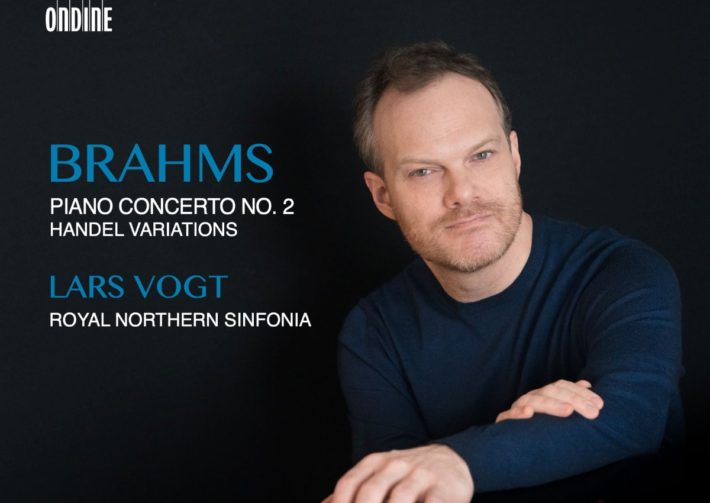Brahms’ Second Piano Concerto is certainly not wanting for new recordings, with more than 150 currently available versions. But as a rare occasion, we have a recording of this piece played and conducted from the keyboard. This may become something of a trend: András Schiff performs this piece in this manner in concerts, and we are told he has recorded it recently with his Cappella Andrea Barca on a period instrument. This is the second volume of Vogt playing and conducting a Brahms Piano Concerto, his previous album with Concerto No. 1 reviewed on these pages. As in the previous volume, Vogt presents a no-less substantial solo piano work to go along with the Concerto, in this case the difficult “Handel Variations” Op. 24.
The Second Piano Concerto shows Brahms in full command in composing for the orchestra, with especially lovely horn writing throughout the work, as well as the justly famous cello solo in movement three (is the solo a flirtation with his beloved Clara Schumann, whose own piano concerto features a cello solo in its second movement, more than 40 years earlier?). Brahms’ Second Concerto has four movements (instead of the normal three) and a persuasive argument can be made to consider this a concerto-symphony, the piano part being an integral part of the orchestral texture. Many passages have a chamber-music atmosphere, and indeed those sections are the strongest moments in this new recording.
That atmosphere is immediately apparent in the dialogue between horn and piano that begins the first movement. And the Royal Northern Sinfonia certainly create an accompaniment of the utmost sensitivity and refinement for their cello colleague in the slow movement (track 3). Vogt is especially beguiling here – listen at 5’45” to the rich autumnal coloring he and the clarinets conjure – indeed the third movement is a complete success. I was less convinced, however, by Vogt’s decision to begin the opening bars of the first movement so much slower than Brahms’ tempo indication (Allegro non troppo/quarter note = 92). Vogt’s initial tempo is quarter note = 60, though he suddenly adopts the requested tempo at bar 11 (0’44”).
The lack of a conductor becomes apparent mainly in transitional material. In the first movement (1’36” forward), listen to the subtle and convincing use of rubato Vogt elicits from the orchestra, but at 2’55” the energy level drops and the polyphony between winds, high and low strings muddies. One also notes that the Royal Northern Sinfonia’s smaller string section sounds undernourished in comparison to other versions, say the Gewandhausorchester Leipzig for Freire and Chailly or the Mozarteumorchester Salzburg for Hough and Wigglesworth.
While Vogt’s performance of the second movement is impressively fierce, there are moments when forward momentum seems to sag, whereas Freire’s reading seems more intensely fierce and forbidding with Chailly conducting, the entire movement crackling with energy. And while Chailly’s tempo change at 4’24” sounds perfectly natural, Vogt’s shift (4’24” forward) sounds disjointed. Wigglesworth, like Vogt, slows down into a new tempo, but in a more convincing way (4’35”). And in the final movement, Vogt’s reading downplays the Hungarian flavoring in which Wigglesworth and Chailly revel.
Related Classical Music Reviews
- Review: Brahms – Piano Concerto No. 1, Four Ballads – Lars Vogt
- Review: Brahms Complete Symphonies – Berlin staatskapelle, Daniel Barenboim
- Review: Brahms – Violin Concerto, Double Concerto – Yang, Schwabe, DSO Berlin, Wit (Naxos)
The companion piece is a thrilling interpretation of the Handel Variations, featuring a great variety of tonal color, wide range of dynamics and a masterful sense of the music’s overall structure. Vogt clearly relishes Brahm’s rhythmic displacement in variations 2 and 3, and his adherence to Brahm’s dynamic and articulation markings in variations 4 and 7 are especially impressive. In Variations 5, 11 and 12, Vogt is intensely lyrical, playing with a subtle rubato and rounded tone that makes the piano seem to sing.
On this website’s review of Vogt’s Mozart Piano Sonatas recording, Leighton Jones has found the pianist’s left hand “prevalent and meticulous”. Throughout the Variations, he presents the same meticulousness in left-hand voicing – listen to how it clarifies the writing in variations 14 and 21-22 (12’51” and 22’30”). The polyphony in the final fugue builds to a thrilling climax.
There is a great deal to admire and to think about in the concerto performance; the same is true of the first release. Both Ondine recordings are very good, and the smaller string section ensures the winds have a more prominent place in the orchestral color. Nevertheless, in both recordings there is less space around the sound, and in this newest volume, climaxes are a tad congested and somewhat constricted. Neither release matches the excellence of the Hyperion and Decca albums mentioned earlier. The solo works are uniformly successful and in repeated hearing I found more to admire in the music and Vogt’s playing. But for the concertos my first choices remain Freire/Chailly and Hough/Wigglesworth. All three recordings will surely enrich and deepen your understanding and love of this music.

Brahms – Piano Concerto No. 2, Op. 83, Handel Variations, Op. 24
Lars Vogt – Piano and Conductor
Royal Northern Sinfonia
Ondine, CD ODE 1346-2
Brahms Piano Concerto No. 2 – Recommended Comparisons
Read more classical music reviews or visit The Classic Review Amazon store
Follow Us and Comment:
[wd_hustle id=”HustlePostEmbed” type=”embedded”]











